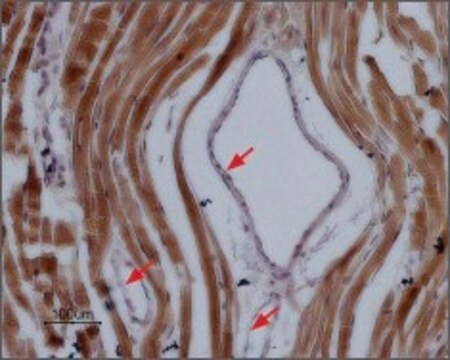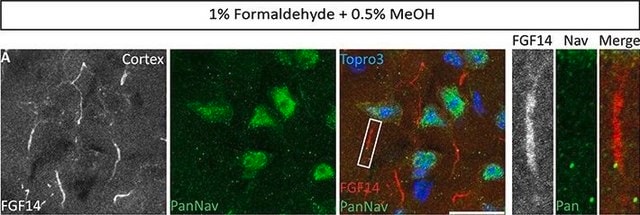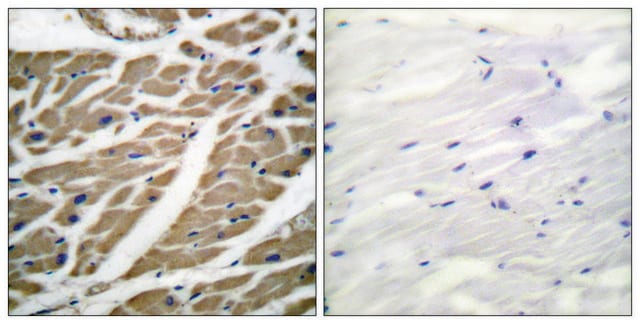AB5493
Anti-Sodium Channel Nav1.5 Antibody, pain
Chemicon®, from rabbit
Synonym(s):
SCN5A
Sign Into View Organizational & Contract Pricing
All Photos(1)
About This Item
UNSPSC Code:
12352203
eCl@ss:
32160702
NACRES:
NA.41
Recommended Products
biological source
rabbit
Quality Level
antibody form
affinity purified immunoglobulin
antibody product type
primary antibodies
clone
polyclonal
purified by
affinity chromatography
species reactivity
rat
manufacturer/tradename
Chemicon®
technique(s)
western blot: suitable
NCBI accession no.
UniProt accession no.
shipped in
wet ice
target post-translational modification
unmodified
Gene Information
human ... SCN5A(6331)
Specificity
Recognizes Nav1.5 (Scn5a, SKM2). The epitope specific for Nav1.5 is not present in any other known proteins.
SPECIES REACTIVITIES:
The immunogen sequence is identical in mouse and conserved in human (17/19). Reactivity with other species has not yet been tested.
SPECIES REACTIVITIES:
The immunogen sequence is identical in mouse and conserved in human (17/19). Reactivity with other species has not yet been tested.
Immunogen
Highly purified peptide corresponding to residues 493-511 of rat Nav1.5 (Accession P15389).
Application
Anti-Sodium Channel Nav1.5 Antibody, pain is an antibody against Sodium Channel Nav1.5 for use in WB.
Research Category
Neuroscience
Neuroscience
Research Sub Category
Ion Channels & Transporters
Ion Channels & Transporters
Western blotting: 1:200 using ECL on rat heart membranes. See suggested protocol.
Dilutions should be made using a carrier protein such as BSA (1-3%).
Optimal working dilutions must be determined by the end user.
Dilutions should be made using a carrier protein such as BSA (1-3%).
Optimal working dilutions must be determined by the end user.
Physical form
Affinity purified immunoglobulin. Lyophilized from PBS, pH 7.4, containing 1% BSA, and 0.05% sodium azide. Reconstitute with 50 μL of sterile distilled water. Centrifuge antibody preparation before use (10,000 x g for 5 min).
Storage and Stability
Maintain lyophilized material at -20°C for up to 6 months from date of receipt. After reconstitution maintain at -20°C in undiluted aliquots for up to 6 months. Avoid repeated freeze/thaw cycles.
Analysis Note
Control
Included free of charge with the antibody is 40 μg of control antigen (lyophilized powder). For negative control, preincubate 1 μg of purified peptide with 1 μg of antibody for one hour at room temperature. Optimal concentrations must be determined by the end user.
Included free of charge with the antibody is 40 μg of control antigen (lyophilized powder). For negative control, preincubate 1 μg of purified peptide with 1 μg of antibody for one hour at room temperature. Optimal concentrations must be determined by the end user.
Other Notes
Concentration: Please refer to the Certificate of Analysis for the lot-specific concentration.
Legal Information
CHEMICON is a registered trademark of Merck KGaA, Darmstadt, Germany
Disclaimer
Unless otherwise stated in our catalog or other company documentation accompanying the product(s), our products are intended for research use only and are not to be used for any other purpose, which includes but is not limited to, unauthorized commercial uses, in vitro diagnostic uses, ex vivo or in vivo therapeutic uses or any type of consumption or application to humans or animals.
Not finding the right product?
Try our Product Selector Tool.
hcodes
pcodes
Hazard Classifications
Aquatic Chronic 3
Storage Class
11 - Combustible Solids
wgk_germany
WGK 3
Certificates of Analysis (COA)
Search for Certificates of Analysis (COA) by entering the products Lot/Batch Number. Lot and Batch Numbers can be found on a product’s label following the words ‘Lot’ or ‘Batch’.
Already Own This Product?
Find documentation for the products that you have recently purchased in the Document Library.
Thomas E Finger et al.
The Journal of comparative neurology, 525(7), 1743-1755 (2017-02-06)
The ionotropic serotonin receptor, 5-HT3 , is expressed by many developing neurons within the central nervous system. Since the olfactory epithelium continues to generate new olfactory sensory neurons (OSNs) throughout life, we investigated the possibility that 5-HT3 is expressed in
Sharon L Rowan et al.
PloS one, 7(1), e29082-e29082 (2012-01-12)
Although denervation has long been implicated in aging muscle, the degree to which it is causes the fiber atrophy seen in aging muscle is unknown. To address this question, we quantified motoneuron soma counts in the lumbar spinal cord using
Anna Lysakowski et al.
The Journal of neuroscience : the official journal of the Society for Neuroscience, 31(27), 10101-10114 (2011-07-08)
Many primary vestibular afferents form large cup-shaped postsynaptic terminals (calyces) that envelope the basolateral surfaces of type I hair cells. The calyceal terminals both respond to glutamate released from ribbon synapses in the type I cells and initiate spikes that
Shih-Lin Chang et al.
Experimental and therapeutic medicine, 13(2), 771-779 (2017-03-30)
The impact of heart failure (HF) on sinoatrial node (SAN) channel regulation and electropharmacological responses has remained elusive. The present study aimed to investigate the effects of HF on the electrical activity of SANs with and without pharmacological interventions. Action
NaV1.5 sodium channel window currents contribute to spontaneous firing in olfactory sensory neurons.
Christopher T Frenz et al.
Journal of neurophysiology, 112(5), 1091-1104 (2014-05-30)
Olfactory sensory neurons (OSNs) fire spontaneously as well as in response to odor; both forms of firing are physiologically important. We studied voltage-gated Na(+) channels in OSNs to assess their role in spontaneous activity. Whole cell patch-clamp recordings from OSNs
Our team of scientists has experience in all areas of research including Life Science, Material Science, Chemical Synthesis, Chromatography, Analytical and many others.
Contact Technical Service







